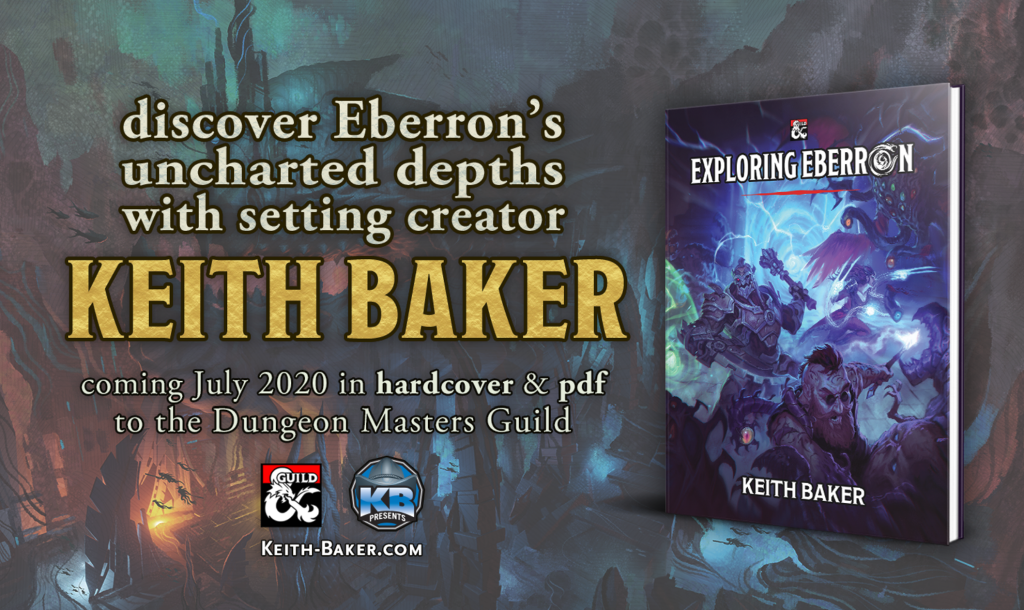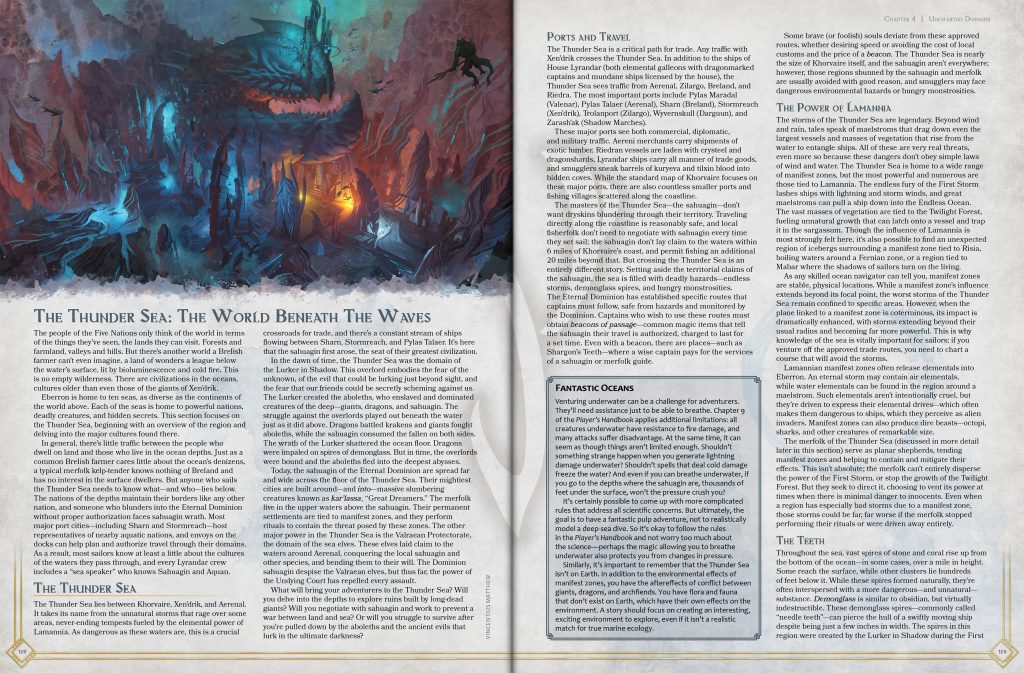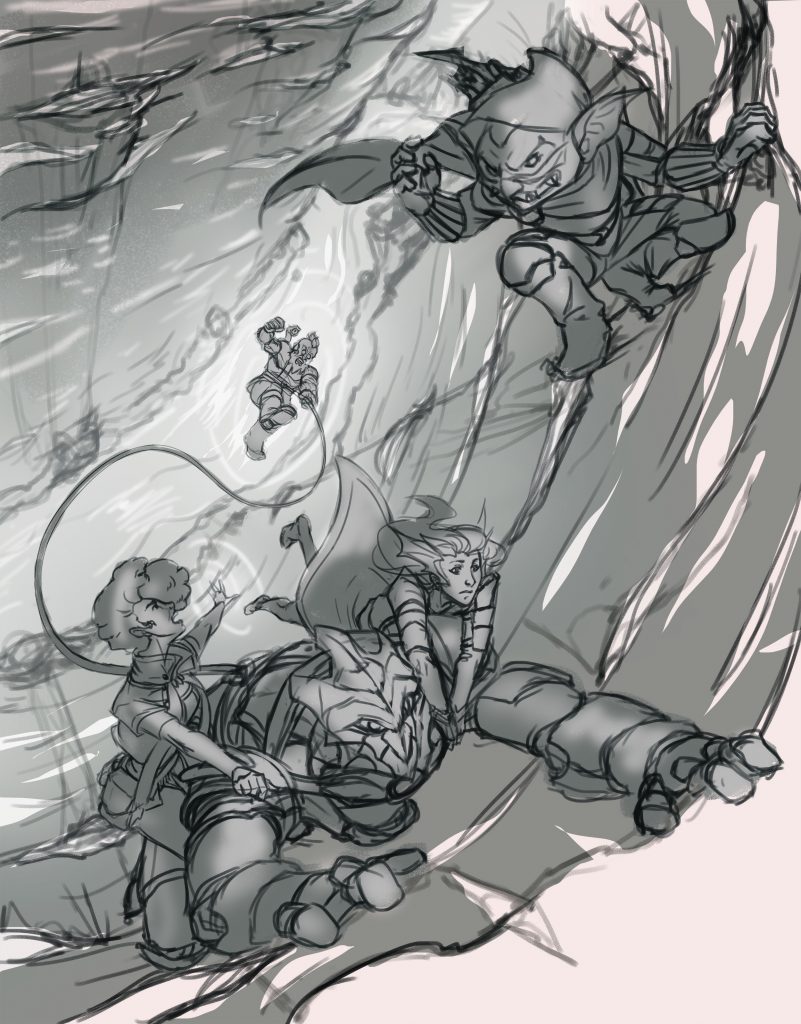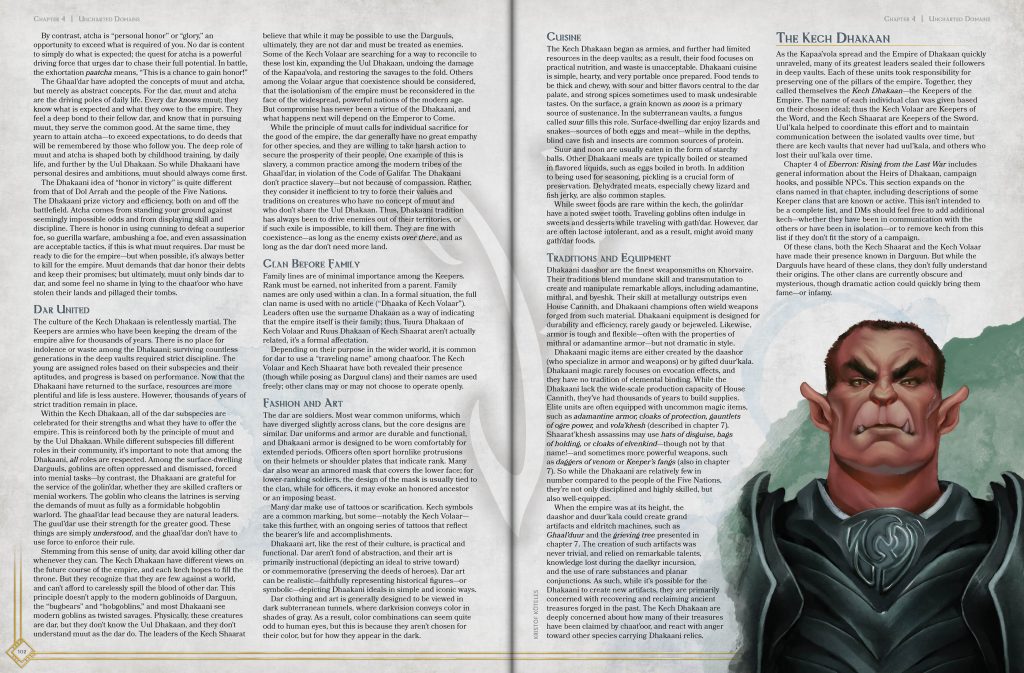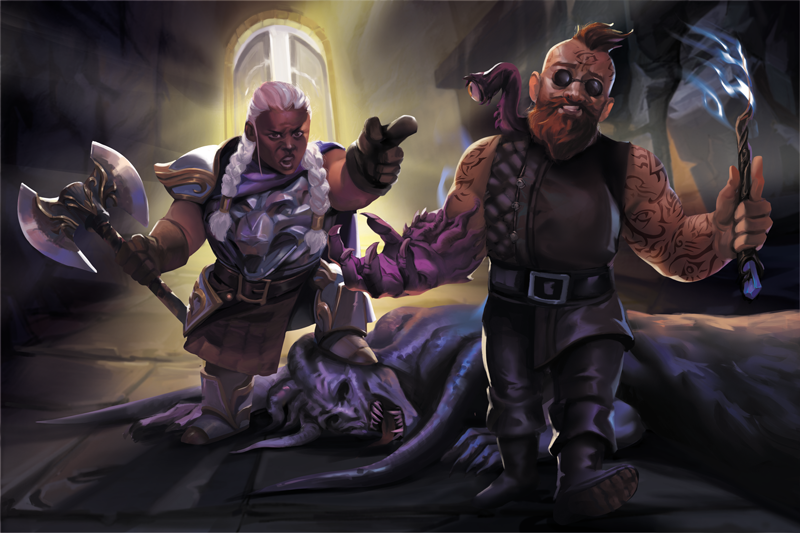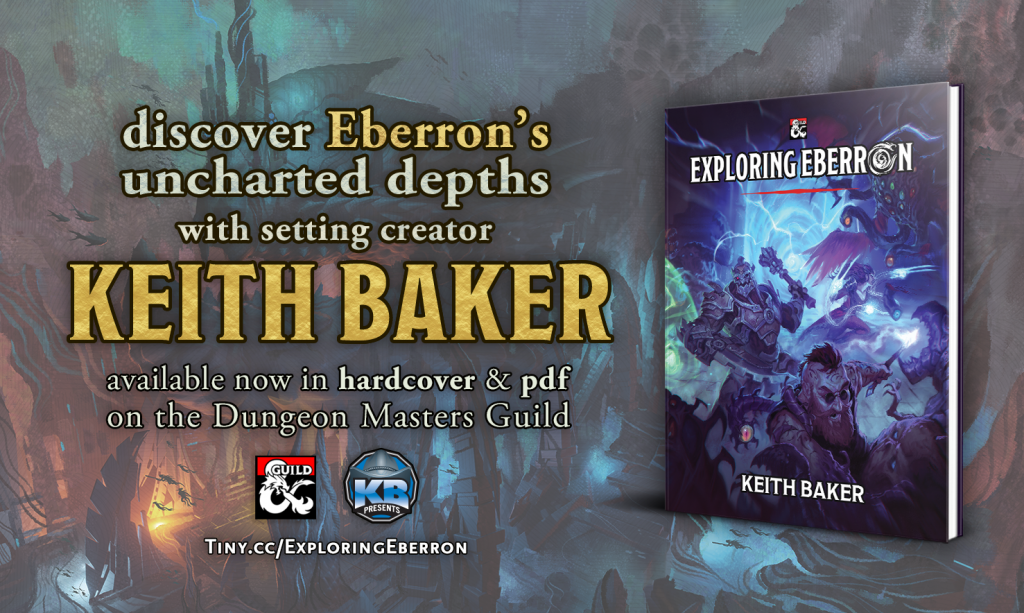
Exploring Eberron is now available on the DM’s Guild. I wanted to take a moment to answer questions about the book, both general questions and some very specific ones…
GENERAL
What’s “Exploring Eberron?”
Exploring Eberron (ExE) is a 248 page sourcebook for the Eberron Campaign Setting, using the fifth edition rules of Dungeons & Dragons. It’s written by setting creator Keith Baker (hi!) along with Will Brolley, Wayne Chang, and Laura Hirsbrunner.
No, I mean what’s IN the book?
ExE is a deep dive into elements of Eberron that haven’t been explored in past sourcebooks, including the planes of Eberron, the aquatic civilizations of the Thunder Sea, Droaam, the Dhakaani goblinoids, the Mror Holds, and the Last War, along with Keith’s personal thoughts on the religions and races of Eberron. All in all, about 200 pages of the book are lore, with a heavy focus on how you can use this information to generate interesting stories or characters. The remaining 48 pages include new races, subraces, feats, backgrounds, archetypes. magic items, and monsters. You can check out the table of contents here.
Is it official content?
No. This is not produced by WotC and it does not match all previous canon sources. This is Keith’s personal view of Eberron and what he does in his Eberron campaigns.
Where can I get it? What formats?
Currently, Exploring Eberron is exclusively available on the DM’s Guild. It’s available as a PDF or as a print-on-demand hardcover. A bundle allows you to get the PDF for $5 when you buy the hardcover.
If I buy the PDF now and then want to buy the hardcover later, can I retroactively get the bundle?
No, the DM’s Guild doesn’t have a system in place that makes this possible.
Is it going to be available on D&D Beyond? Roll20? Fantasy Grounds?
It’s not official content and will not be on D&D Beyond, for a host of different reasons. We are exploring the possibility of conversions on other online platforms. At the moment it is only available on the DM’s Guild.
THE PROCESS
What parts of Exploring Eberron were ideas you’d had for years as opposed to ideas you developed while writing the book?
It’s not quite so clear cut. Almost all of the topics in Exploring Eberron are subjects I’ve wanted to write about for a decade. I sketched out the Thunder Sea—with the balance of power between the powerful Sahuagin nation and the sea elf colony, with the neutral, nomadic merfolk—as part of the setting bible in 2003; that setting bible likewise included the idea of the nation of monsters that eventually became Droaam, and the idea of the goblins having lost a great empire. I developed the planes with Bill Slavicsek, James Wyatt, and Chris Perkins as we developed the ECS in 2004. But all I had were the basic IDEAS. I didn’t work out the SPECIFICS of the Sahuagin nation or name the noble line of sea elves. We knew Fernia was the Sea of Fire, but back in 2004 we DIDN’T know exactly how it differed from the elemental planes.
Over the course of the next decade, all of these things evolved in their own way. Writing The Queen of Stone and “Backdrop Graywall” gave me an opportunity to explore Droaam in more depth. I established the basic framework of Mabar in the article I wrote on this blog a few years ago. But that was essentially a first draft. Notably, I said that one of the powers of Mabar was the Queen of All Tears. But at the time, I didn’t know who she was. I had a general vision of a tragic undead figure. But it wasn’t until I was writing the Mabar section of Exploring Eberron that I decided she was once mortal, and thought about what tragic figure from established canon could fit that part. I always knew that the slaadi were residents of Kythri, but it wasn’t until working on ExE that I thought about what made them different from the slaadi of other settings.
So most of the BROAD concepts had been in place for decades; the primary exception would the the Mror Dwarves (with the Realm Below and Ruinbound dwarves), as that’s new angle we specifically developed in Rising From The Last War. But many of the specifics were developed over the last year, because I finally had an opportunity to spend sufficient time to really think them through.
Is there some chapter or meaningful content that didn’t make the final cut of ExE?
There’s not a lot of material that I WROTE that we didn’t use. There’s a few things, like the Shavarath denizens table I’ve posted as a Patreon exclusive. But keep in mind that the book is 80 pages longer than we originally planned, precisely because I DIDN’T want to cut a lot of ideas that I loved. However, it is the case that I had to limit the scope of some of my original ideas. For example, originally I planned to do a write up on each of the major warlords of Droaam, similar in scope and style to the write-up for the Cults of the Dragon Below: describing the warlord, their personality, their history, their minions, their story hooks. We actually commissioned a fantastic image of Sheshka, the Queen of Stone. But as things went on, I realized both that we didn’t have room and that it didn’t actually feel like the right content for what is largely a player-focused book… that it was more appropriate for a book that mainly focused on organizations, threats, monsters, etc. Honestly, that’s the biggest piece of restricted scope that comes to mind, and it’s something I definitely WILL write at some point; it just didn’t fit here. But again, it’s not that I WROTE it and then we cut it; it’s that I realized it didn’t fit, so I DIDN’T write it.
What is your favorite new thing in “kanon” that appears for the first time in this book?
It’s a difficult choice. I love all my children. I’m particularly happy with the Queen of All Tears; I always liked the concept of her, but when the final piece of her story fell into place, it was just such a perfect fit. In general, I’m thrilled with all of the planes; there were a number (Kythri, Risia, Fernia) where initially I wasn’t actually sure they would be especially compelling… but whn I sat down and actually explored the idea, something wonderful came together.
Insofar as you’re thinking ahead right now, are you planning on focusing on your non-Eberron, non-D&D work for a while? When you do your next project for DMG, do you anticipate an adventure pack, or a more focused book of lore? Do you envision ever doing another book on the scale of ExE, or is the prospect too horrifying to contemplate at the moment?
I’m still determining the answer to that question. Wayne and I started working on Exploring Eberron over a year ago, and until last week we didn’t actually know how well it would do. This is what I do for a living, so that matters; if it doesn’t make enough money, I HAVE to pursue work that will keep a roof over my head. So I didn’t make plans for another major book because I didn’t know if I could afford to. But I love writing about Eberron and there are many more elements of the world I WANT to explore; it’s always just been a question of what’s feasible.
I do have non-D&D projects I’m working on, including The Adventure Zone: Bureau of Balance and a new Gloom project I’m working on. And I do want to do SOMETHING with my roleplaying game Phoenix: Dawn Command; I love the system and I’ve wanted to revisit it for some time. However, I still love Eberron and don’t want to lose momentum. I will be continuing to work on this website and working to increase the value of being a Patreon supporter; the more supporters I have, the more I can do with the site.
So having said all of that: Wayne and I have already talked about a number of possible projects for KB Presents. I will say that I’m not going to jump right into another 240 page book; I want to work on a few smaller projects before diving into that again. But I think you’ll be happy with all of the things we’re considering, and I’ll share more once there’s something concrete to share.
I understand you’ve played characters in Eberron games using some of the subclasses in this book. Can you tell us about them?
The preface of Exploring Eberron has an image of a warforged druid. This was a gift commissioned by Wayne; it’s Rose, a warforged druid I played in a campaign run by my friend Dan Garrison, the co-designer of Phoenix: Dawn Command. The campaign began at a party in Metrol on the night of the Mourning, and Dan provided the players with a list of basic character concepts to choose from and expand upon. I chose the warforged companion of the Princess of Cyre, a special commission for the royal family; classes weren’t setting, and I decided the companion would be named Rose, and would have the capabilities of a druid. As I have long loved the idea of warforged druids turning into living construct animals, I did the first pass on what became the Circle of the Forged druid. Long story short: the party was epic; we danced the Tago with knives; Metrol was sucked into Mabar when the Mourning occurred; hijinks ensued.
So Rose actually predated Exploring Eberron by about a year, and the Circle of the Forged druid was the first subclass developed for it. The Maverick artificer was developed before I played one, driven by my love of the flexibility of the 3.5 artificer—specifically, of the 3.5 infusion spell storing item. I love the concept of the artificer as someone who can tinker what you need on the spot. So, when Dan started another campaign—this time set in Callestan, with the players assuming the roles of professional rat-catchers—I decided to play a Maverick. My character is a forest gnome urchin, born in the feyspire of Shae Joridal but orphaned and separated from his home in Ghaal’dar attack; he grew up on the streets of Lower Dura and doesn’t really understand the fey potential in his blood. With this in mind, he uses the Magical Thinking approach to artifice that I describe in ExE. One of my favorite elements is using the guidance cantrip, because every time I cast it I come up with a different explanation for what I’m creating based on the effect I’m assisting with. Someone’s about to make an Investigation check? Try these special spectacles I’ve put together. About to use Athletics to make a dangerous jump? Let me add my pep paste to the bottom of your boots!
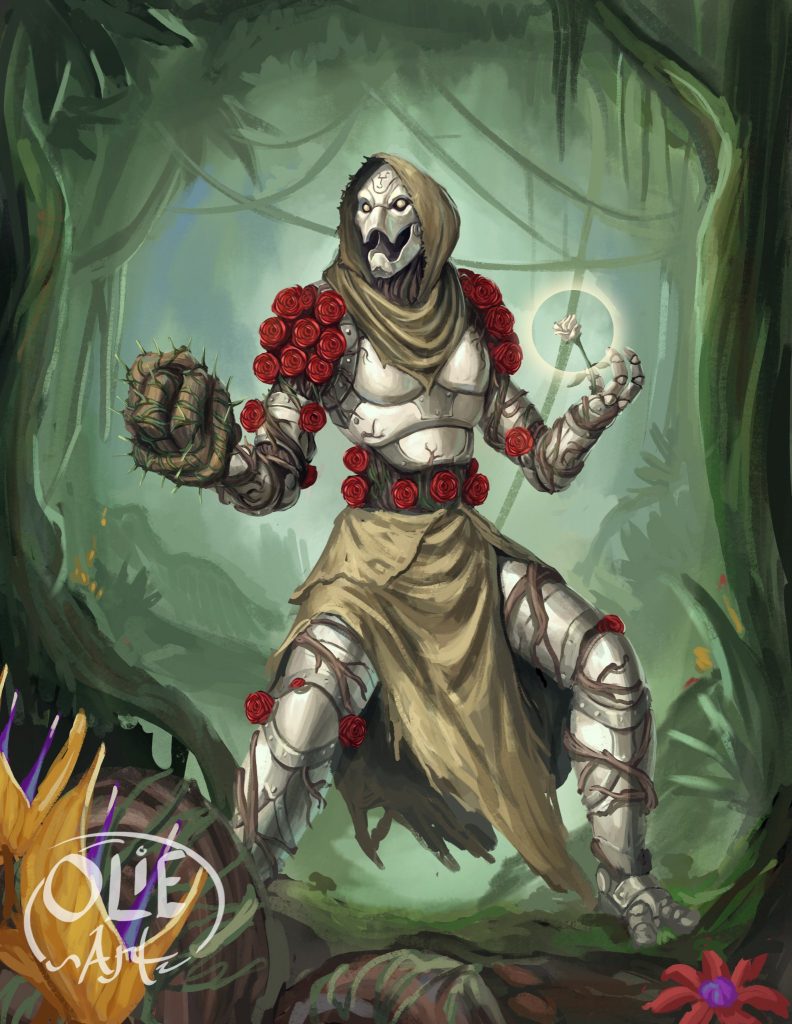
(VERY) SPECIFIC QUESTIONS
Does House Ghallanda have any interest in recreating or importing the odder cuisines presented in the book to the Five Nations (perhaps homogenizing it in the process, see American “Chinese food”)?
I don’t think it’s been suggested, but I think it’s a fantastic idea. Of course, in order to introduce grist to Five Nations they’d have to figure out the secret of how it’s made, and bear in mind that while we’ve told YOU how grist is made, the people of DROAAM don’t even know what it is, and once that secret is uncovered, they have to figure out how the Daughters are making grist actually edible. But I could see a great Ghallanda heist one-shot based on stealing the secret formula for grist…
In Exploring Eberron, it talks about the daelkyr being trapped in specific demiplanes and unable to leave, but I was always under the impression that they were described as “trapped in Khyber” being free to move about in Khyber unlike the Overlords. Is this a shift from canon or did I miss or misunderstand something regarding to this?
It’s not a shift from previous ideas, it’s a clarification. The idea all along was that you can’t FIGHT a bound overlord; they are a spirit in a shard and do not physically manifest. They don’t have kingdoms in Khyber. By contrast, it was always the idea that the daelkyr ARE physically present in Khyber, that they DO have lairs and minions, and that you can go meet one. But it was never clearly explained how they were trapped or what limitations were on their movement. Likewise, the earlier sources suggested that Khyber was strange and wondrous, but never clear how its geography worked. Over the next decade, I presented the idea that Khyber contains many demiplanes—and that entrances to demiplanes can transcend normal space, which explains how Belashyrra could be fighting the Umbragen in Xen’drik and troubling people in the Shadow Marches. It’s not that the domain of the Lord of Eyes spans the Thunder Sea, it’s that the domain is a DEMIPLANE with entrances in both places.
So in ExE I just clearly state this idea. The daelkyr aren’t bound in the physical tunnels of Khyber. They are each bound in a unique DEMIPLANE in Khyber. Within that demiplane they have absolute freedom of movement, so each one rules their own bizarre kingdom. Their minions can leave the demiplane, and again, demiplanes have exits across the world. But the daelkyr can’t leave the demiplane, which finally gives a clear explanation of how they have SOME freedom of movement but can’t “leave Khyber.”
So the IDEA remains: the daelkyr aren’t stuck in shards like overlords. They have realms they rule and you can go meet one and fight one. But those realms are little pockets of reality, and the daelkyr can’t LEAVE them.
There are Krakens and Aboleths underwater, are there equivalents of the Gatekeepers or the Church of the Silver Flame? What about of the couatls themselves?
Underwater? Surely. In the Thunder Sea? No. I’m sure there was an aquatic counterpart to the couatl, and I’m just as sure that they were involved in the same celestial sacrifice that bound the overlords and created the Silver Flame. It’s likewise logical to think that there were serpent cults among the locathah of the Thunder Sea, but they were crushed by the Eternal Dominion and the Valraean Protectorate, both of which do not allow freedom of religion in their realms. You could certainly have a secret Silver Flame tradition lingering among locathah dissidents, but the basic philosophy of the sahuagin is fundamentally opposed to its principles; “the strong should make sacrifices to protect the weak” is NOT a theory that fits in the Eternal Dominion. This doesn’t mean that the sahuagin are unaware of or helpless against supernatural threats; but they are handled by the martial might of the Dominion, not by some religious cult.
The kalamer merfolk are druids who maintain the balance of manifest zones, so they are something of a parallel to the Gatekeepers, but they don’t share any specific traditions with them and have no history with the daelkyr.
Does the Undying Court know about the Queen of All Tears and does it care?
With any question like this, my answer is always what makes the story more interesting? In my opinion, it’s more interesting for this to be a secret the player characters can discover, leaving them to decide what to do with the knowledge, rather than saying “Oh, the Undying Court has known about that for centuries.” Among other things, if the Undying Court already knows about it, then either they don’t care or can’t do anything about it, because they HAVEN’T. If they don’t KNOW, then it leaves open the possibility that they will panic when they find out about it. But in general, I will always lean toward adventurers making a dramatic discovery NOW over NPCs making a dramatic discovery a thousand years ago.
Kind of as a broader version of this question, what level of knowledge do the Material Plane experts possess and to what degree is it relevant to daily living?
The book gives examples of what experts know when it quotes the Planar Codex and other scholars. The limits of what can be known through Arcana depend on where you are and on what the DM WANTS players to know. The Undying Court has spent thousands of years astrally traveling and gathering information, and they likely have the best knowledge of the planes; other scholars may have their information through Aereni accounts.
But in terms of what does EVERYONE know? Pretty much the names of the planes and their basic concepts, and they don’t always get those right. We’ve called out that the typical person thinks of Risia as the “Plain of Ice” and Irian as the “Plane of Light” and don’t understand the deeper symbolic roles of these places. People know about them because of manifest zones, but without an Arcana check they don’t know much.
Fernia and Risia seem to have moved away from the mildly evil aligned, while Syrania moved away from mildly good aligned. What led to those decisions?
I’d argue that Risia IS still mildly evil-aligned. Here’s a quote:
At first glance, Risia appears to be barren and empty. But some travelers have described a presence, a sense of being watched, and most feel this presence is malign. On the surface, the concept of Risia seems entirely neutral; there’s nothing inherently evil about ice. But there’s a hunger to Risia—an innate desire to consume warmth and to bury living things in ice. In the Planar Codex, Dorius Alyre ir’Korran calls this force the Killing Cold.
Exploring Eberron, page 182
By contrast, my view of Fernia is that it explores all symbolic associations of fire, both benevolent and destructive, and shouldn’t be inherently evil. Syrania is primarily about commerce and knowledge and didn’t need to be inherently good; this also helps to clearly differentiate it from Irian. Beyond that, I didn’t assign those specific traits in the original ECS, and Exploring Eberron is about how I see things, not canon.
I’m a big fan of Sarlona, but I don’t think I’ve ever seen HOW the kalashtar are slipping Riedra’s net and getting to Khorvaire. Is this ever spelled out?
There’s no steady stream of kalashtar into Khorvaire. As for how immigrants have managed it, they’ve done it in small numbers and disguised as humans. They’ve made their way to Arhdman in the Syrkarn, or worked with smugglers using the secret port of Dvaarnava. Some have made a dangerous pilgrimage through Khyber. And there have been one or two bold strokes that have involved major operations to disrupt or draw away the Riedran blockades. But it’s NOT a trivial thing, and they never travel openly under a flag of Adar.
There’s a bit about magic making permanent changes to the body being a relatively common thing. How does this work with the description on identification papers?
Actually, permanent changes are NOT common. Here’s the text from the book, with a few highlights.
Minor cosmetic transmutation is quite common; most professional beauticians can change your hair or eye color. Unnatural effects are rarer, seen mainly in Aundair and Zilargo… The effects of cosmetic transmutation typically last a week, but if you’re dealing with a magewright of sufficient skill, you can extend the effect to one month. In some cities, you might even find an expert who can make the change permanent. The more complicated the transmutation, the more costly—and hard to find—the service becomes.
Exploring Eberron, Page 28
So first of all, permanent transmutation is not common. What’s common is turning your brown hair red for a month, or getting permanent eyeshadow for a week — the sort of cosmetic changes people get in OUR world, and I don’t have to update my driver’s license when I change my hair color. Exotic changes — like having, say, silver hair or cat’s eyes — are NOT common and are generally only seen in the cities of Aundair or Zilargo, where people are used to a higher degree of arcane experimentation. Permanent transformation is not only out of the price range of most people, but it’s also not something that’s available most places — again, in a major city, you might find someone who can do it. And as noted later in the section, “as with any magewright, beauticians are often specialized; a hairdresser might be able to give you permanent exotic hair but be unable to change any other feature.”
A second point is that identification papers aren’t something you need in everyday life. The ECS calls out that they’re typically carried by members of the middle and upper classes; so common laborers don’t even have identification papers. They’re primarily going to be used when crossing borders, using letters of credit, or similar situations; but you don’t need to show identification papers to buy a beer at the Gold Dragon Inn. If your papers are accurate except for your silver hair, no one’s going to question that you had your hair done. If you ARE going to engage in permanent, dramatic physical transformation—changing your apparent species, gender, height, or the like—you will want to get your papers updated. .
I had a question about the Dol Udar. Are the Gatekeepers at all aware of it?
Keep in mind that the Gatekeepers aren’t a powerful, modern faction with widespread resources. They’re the last remnants of an order that has been in decline for thousands of years, dwelling in a backwater with almost no contact with the modern nations, doing their best to maintain the ancient seals that keep forgotten evils at bay. With that in mind, consider that the Gatekeepers don’t NEED to know what the daelkyr are doing elsewhere in the world; they know that as long as they preserve the seals, the daelkyr cannot escape their prisons—and again, the seals are NOT geographically linked. There’s no Gatekeeper seals in the Mror Holds; the seals that exist prevent Dyrrn from leaving his demiplane, no matter where it touches the world.
With all that in mind, the whole point is that THIS IS WHY THEY NEED PLAYER CHARACTERS. What’s a more compelling story—the Gatekeepers having vast resources and knowing exactly what’s going on? Or the Gatekeepers knowing that they DON’T know exactly what’s going on in the wider world and needing to send a young, promising champion—a player character—to investigate the disturbances they’ve felt in the distant east? With that said, if you DON’T have a PC in this role and your player characters are active in Dol Udar, you could introduce an NPC in that role—a Gatekeeper agent who’s been sent to investigate the situation and provide assistance. But I’d still play that as they don’t KNOW what’s going on, so they’ve sent an agent to find out as opposed to they’re entirely aware of the situation and have already made plans to deal with it.
If you have questions about Exploring Eberron, post them below and I’ll answer when I can!

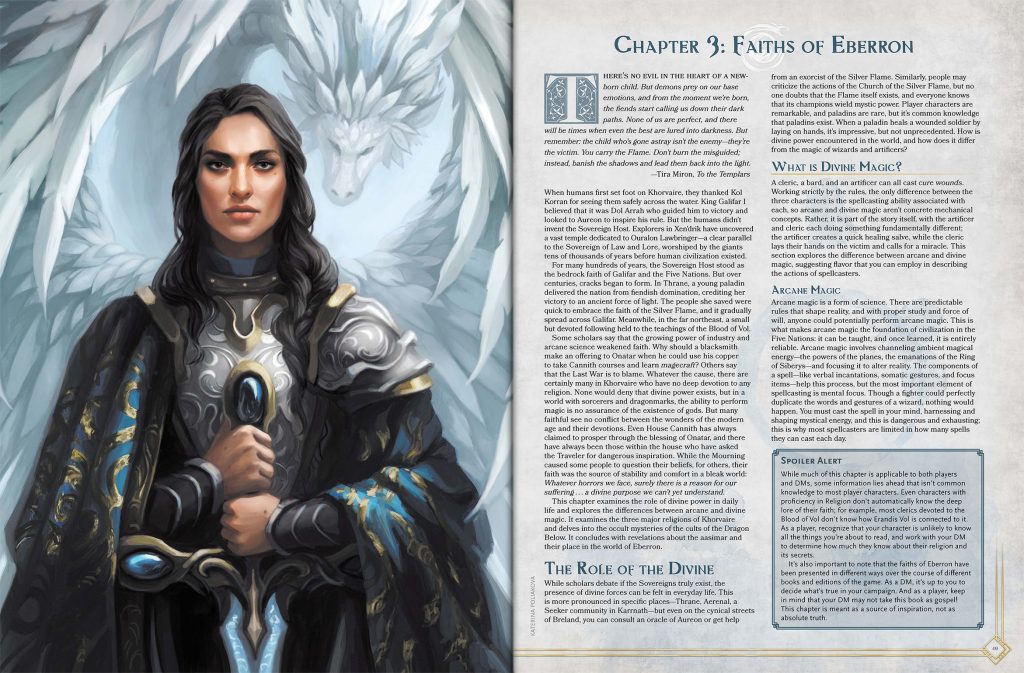
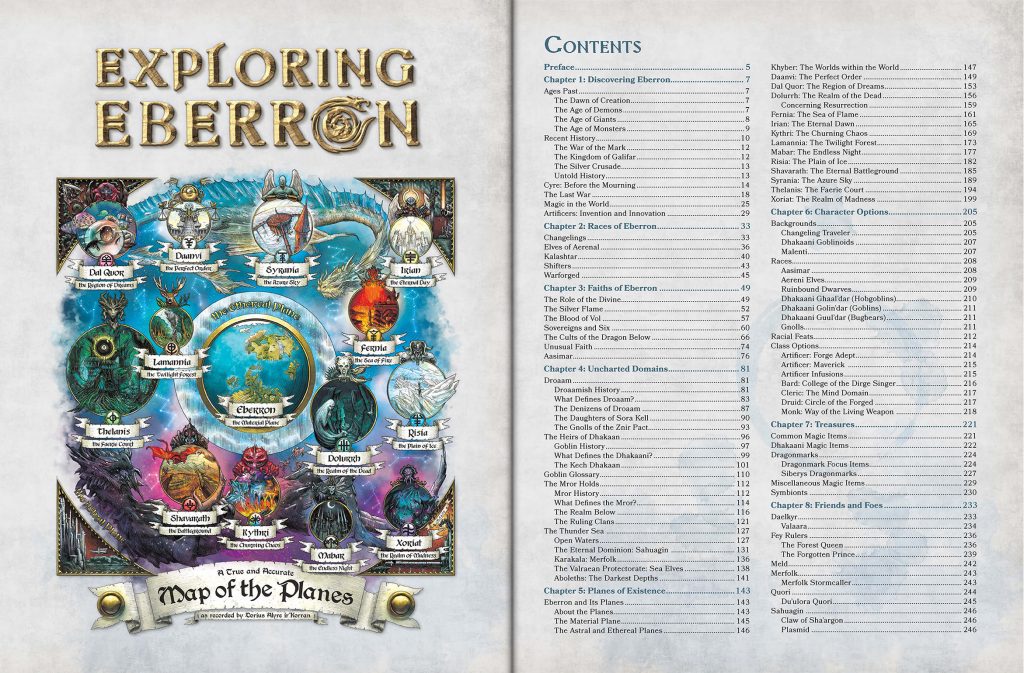
 Unlock with Patreon
Unlock with Patreon